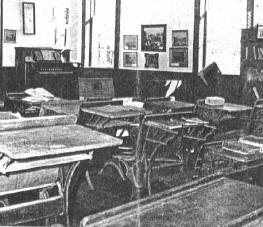OAKVILLE SCHOOL-IN TIMES PAST
Many people remember the days when going to school meant joining all the
local children in a one room building to share the knowledge of one lonely
teacher, Many others wonder what "going to school" was like in those far-distant
days.
Oakville School gives an accurate representation of a tradition which is
quickly fading from the American scene. Whether one returns to reminisce or just
to take a curious look at the past, Oakville instills in each visitor a deeper
reverence for days which are no more.
 The old fashioned wooden
desks, the pot-belly stove, the little slate boards-all suggest an era when
rugged pioneer children took time off from their multitude of chores to attend
to the serious business of learning how to read and write.
The old fashioned wooden
desks, the pot-belly stove, the little slate boards-all suggest an era when
rugged pioneer children took time off from their multitude of chores to attend
to the serious business of learning how to read and write.
The first pioneers settled in the Oakville area around 1837. In 1840, after
having attended to the more necessary business of building homes and clearing
the land, everyone joined together to build a school for the children.
Daniel Shottenkirk was then hired as the first teacher at a salary of about $25
per month.
As the community began to grow, small businesses started to appear. Oakville
boasted a blacksmith's shop, a molasses mill, an oatmeal roller and a barbed
wire shop.
The original school soon became inadequate and a larger brick building was
built in 1855. The school became an all-purpose building for the community and
served not only as a church but as a social center. Many cold winter evenings
the parents of the school children gathered around the pot-belly stove for their
own spelling bee. Outside a peaceful little graveyard began to grow on the
northern edge of the school yard.
In 1888 a tragedy struck the Oakville community. The school house burned to
the ground and was so severely damaged that not even the old bricks could be
used. Construction began right away and a new brick building was erected.
This same building stands, to this very day on it's original location next to
the old graveyard.
After a short time, however, the new schoolhouse was unable to accommodate
the growing population of Oakville. At one period there were 60 children of all
sizes, other, better places to go to school. In 1945 only five children showed
up for classes and Oakville closed its' doors forever.
 The
Carroll County Historical Society determined the fate of the old building when
it was restored and opened to the public. Furniture, books, and other articles
remain much the same as they were 100 years ago. Standing in the center of the
room you almost expect to hear the bell ring and see little girls in calico
dresses and unruly barefoot boys in knee breeches dash to their respective
desks. An old map of Carroll County, made in 1869, hangs in the back of the
room. On the teachers' desk lie record books from different years giving the
date, the weather and the number of children absent.
The
Carroll County Historical Society determined the fate of the old building when
it was restored and opened to the public. Furniture, books, and other articles
remain much the same as they were 100 years ago. Standing in the center of the
room you almost expect to hear the bell ring and see little girls in calico
dresses and unruly barefoot boys in knee breeches dash to their respective
desks. An old map of Carroll County, made in 1869, hangs in the back of the
room. On the teachers' desk lie record books from different years giving the
date, the weather and the number of children absent.
The old log cabin was also restored and moved to a location nearby the
schoolhouse. It has been furnished in a manner resembling as closely as possible
the style in which the early pioneers lived. Toys and kitchen utensils lie
about, ready for use, and in the loft above, quilts and bedding are stacked in
preparation for the night.
If you care to remember the days when you attended a one-room country school
or if you've always wondered what it was really like, Oakville presents a
splendid opportunity. Anyone who wishes to visit the old school need only make
an appointment with a member of the Carroll County Historical Society, Mr. C. R.
(Jim) Colehour is president of the group.
The past can never be captured and made to stand still, but fragments of it
can be preserved through articles and moods. The Historical Society has taken
the remnants of Oakville's past and molded them into a moment of time, preserved
for the enjoyment of all lovers of bygone days.
